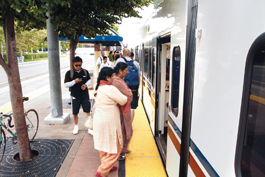home | metro silicon valley index | news | silicon valley | news article

Photograph by Felipe Buitrago
STAYING ON TRACK: Following a year when ridership grew, the VTA is now being forced to cut routes and raise fares. Riding Out the Crisis
Riding Out the Crisis
VTA is forced to cut back service, even as demand (finally) surges
By Danny Wool
FIFTY-THREE hours. Jack Bauer could save the world twice in that time and still get a good night's sleep. Of course, he doesn't have to deal with Silicon Valley traffic. And 53 hours is the amount of time the average commuter spends snarled up in local traffic each year.
It's a 6-1/2-day forced furlough, and it's no real consolation to think that this is just two hours above the national average, or that traffic is even worse in San Francisco.
The Urban Mobility Report released earlier this month by A&M University, which finds San Jose the sixth-worst city in the nation for traffic, puts the problem into perspective. Concerned about the economy? Traffic congestion nationwide cost $87.2 billion—or 3 1/2 times California's crippling deficit. Worried about our dependence on foreign oil? The 2.8 billion gallons of fuel wasted in 2007 could fill 370,000 oil tankers. The 2.8 billion gallons of wasted gas uses up 10 percent of the country's proven oil reserves—in one year.
One obvious solution to the problem is an expanded role for public transportation. This was recognized in a campaign fact sheet on transportation infrastructure released by the Obama presidential campaign, which stated: "Public transit not only reduces the amount of time individuals spend commuting, but also has significant benefits to air quality, public health and reducing greenhouse gas emissions."
And public transit use appears to be on the rise. The VTA saw record use last summer, just as gasoline prices peaked. After doing the math, people realized that taking the bus or the train was considerably cheaper (and with traffic, considerably quicker) than depending on private automobiles. It still is.
According to Jennie Hwang Loft, public information officer for the VTA, when considering the cost of gasoline and parking, people can save up to $9,000 a year simply by taking public transportation.
So what went wrong? On Aug. 6, the board of directors of the VTA will be deciding whether to slash bus service by 8 percent, and light rail service by 7 percent. Wages are frozen, and VTA workers are still being forced to take furloughs of up to 12 days per year, losing 5 percent of their salaries. Another 80 employees could still be laid off to cope with growing budget deficits.
Fares are likely to increase too, three months ahead of schedule, with a single ride swelling from $1.75 to $2 and a monthly pass from $61.25 to $70. While this may increase revenue, it could also cause the number of riders to drop by as much as 3 percent.
According to Loft, there are several reasons why the VTA must consider these measures. Gas prices dropped, so people returned to their cars, and the State Transit Fund, a key source of funding, was eliminated. Then last month the VTA received the bad news. Sales tax receipts were down 21 percent in the third quarter of 2009, instead of an anticipated 8 percent. The resulting loss was $6 million dollars. All efforts to reduce the operating cost deficit were stymied.
One possible solution could be federal stimulus money. Last week's Committee of the Whole meeting authorized VTA general manager Michael Burns to continue applying for federal grants and to execute existing grant agreements. To date, the Bay Area has received more than $1 billion in federal funding for transportation infrastructure, with $495 million going to the Metropolitan Transportation Commission (MTC), a nine-county coalition of public transportation providers. The VTA alone has received more than $56 million in ARRA (American Recovery and Reinvestment Act) funding for four shovel-ready projects and the purchase of up to 107 new, environmentally friendly diesel-powered buses.
The question then is what should federal stimulus money be used for? When policy makers in Sacramento attempt to draft a workable budget, it is tempting for them to ignore basic road maintenance, claiming that the local authorities can use stimulus funds precisely for this, rather than investing the money in long-term projects. The same is true of public transportation. Stimulus money could be used to expand and enhance public transportation, but it can just as easily be used to keep buses and trains running over the coming year.
San Francisco.com Real Estate
Moving to the Bay Area just became easy. Let San Francisco.com show you all the homes currently for sale.
San Jose.com Real Estate
Relocating to San Jose or Silicon Valley? Let San Jose.com introduce you to some expert area real estate agents.
Randy Rentschler, a director of the MTC, says that when it came to apportioning stimulus money to local public-transport providers, that decision was left in the hands of each district. Some services, such as AC Transit in the Alameda and Contra Costa Transit District, decided that their primary objective at present was to maintain existing services. The VTA seems to have taken an alternative approach, with an eye on strategic planning for the future—modernizing its bus fleet, improving shelters, replacing rails and adding HOT Connectors.
Jennie Loft admits that the VTA would like nothing more than to stabilize or even reduce fares to make it even more attractive to commuters, but says that that is just about impossible under the current economic conditions. She adds that when all the costs involved in running an automobile are calculated, it is still a bargain for commuters.
It is also likely that those same commuters want nothing less than to spend 53 hours a year caught in traffic snags, when they could be at work or at home.
Send a letter to the editor about this story.
|
|
|
|
|
|
